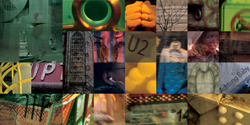Pretty Ordinary Love
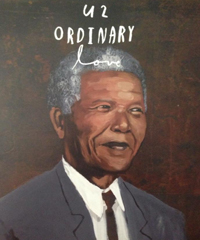 While U2 fans around the world are waiting, with the utmost patience for a new full-length album release, the band gave us a soundtrack single, recorded for the movie Mandela: Long Walk to Freedom. The song I am speaking of, Ordinary Love, has been floating around the Internet for the past few weeks in various incarnations and now, we can finally put it on our record players while comparing it to other U2 one-offs in a very open light.
While U2 fans around the world are waiting, with the utmost patience for a new full-length album release, the band gave us a soundtrack single, recorded for the movie Mandela: Long Walk to Freedom. The song I am speaking of, Ordinary Love, has been floating around the Internet for the past few weeks in various incarnations and now, we can finally put it on our record players while comparing it to other U2 one-offs in a very open light.
Before I proceed, we need to look at other soundtrack songs that U2 have created for movies, most notably The Hands That Built America, for the movie The Gangs of New York and Hold Me, Thrill Me, Kiss Me, Kill Me, from Batman Forever. Each of these tunes were released between albums, but I’m not sure either had the anticipation level as Ordinary Love has in concern to their long absence of from a full fledged release. Why you ask? Each of these songs wasn’t caught in the mix of the band trying to flesh out new material. Hold Me, Thrill Me, Kiss Me, Kill Me originated as an idea during the band’s Zooropa album sessions and then later became a song for the movie when asked to score a song. The Hands That Built America, on the other hand, was actually scored for the movie Gangs of New York, much like Ordinary Love, because it gave them an opportunity to work with Martin Scorsese, which brings us to the discussion of how U2 formulates score material.
If we took both compositions, Ordinary Love and The Hands That Built America, and listen to them back-to-back, they would seem to be one in the same. Both use a three-chord melody intro that ignites the tune and start the ignition switch to Bono’s lyrics. One solid note on both songs is that Edge has abandoned the guitar in both songs and supplanted himself behind the keyboard as musical director. Now, I know that these are soundtrack tunes and there really is no area for them to push beyond the creative scope as they would for album work. However, U2 has found a formula and are milking it while we gaze at their wonder, hoping for anything new from the band.
What I want to do to prove my point about U2 soundtrack formulation by visiting The Hands That Built America’s album companion Electrical Storm, from U2 – The Best of 1990-2000 release because we will see a common theme in lyrical narrative and composition to Ordinary Love even though Electrical Storm isn’t a movie soundtrack tune, but could easily apply for one.
Let’s review the opening verses below:
The sea it swells like a sore head
And the night it is aching
Two lovers lie with no sheets on their bed
And the day it is breaking
…Electrical Storm
The sea wants to kiss the golden shore
The sunlight warms your skin
All the beauty that’s been lost before
Wants to find us again
…Ordinary Love
As we see, Bono sets the narrative in both songs, using the sea as a metaphor. We know he comes from Ireland where the sea has played a vital role in many an Irish literary work, yet he seems to re-examine it as though he is drawn to it whenever melancholy is needed. In the case of Ordinary Love, Bono’s rehashing of the aquatic metaphor is laughable because we know that the city of Johannesburg, where Mandela grew up, is land locked and nowhere near an ocean, which is where I make my stand on this song not being a stellar U2 track. Even more important is how the melody tends to take the same navigational map in Ordinary Love as it does in Electrical Storm. There is no triangle being played in Ordinary Love, but there is syncopation in the background, that is setting the song up for the Bono’s spoken lyrics, is much like melody, which exists in Electrical Storm. In my mind, and I am sure you will agree once you listen to them side-by-side, that the U2 xerox machine just hit copy.
I know it’s hard for this long-time fan to make these unsympathetic statements about a band we all like, but it is an honest critique. What really scares me is how U2 dialed this song in as they were in the midst of working on a comeback album. An album that I hope has a new sonic vision, such as what was delivered to us on Achtung Baby or Pop. Harsh as I sound, U2 needs a kick in the creative ass and needs to release us something that trumps the last three projects. As I have said before, All That You Cannot Leave Behind was a way to bring back those they left behind after Pop and subsequent releases have failed to bridge significant sea change in the U2 aural/narrative creation (Sorry for the pun, but if he can use it, so can I). However, the argument can be made that they can still fill stadiums and I agree, but by the third leg of the 360 tour, only a few songs remained from the No Line On The Horizon release, a telling tail that this band has to create an album that needs to revolve at least 180 degrees from the previous.
The last great film critic
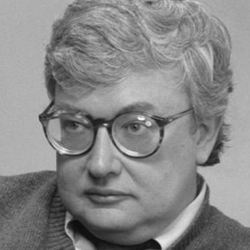 I moved to Chicago some 23 years ago for a few reasons. One was the better opportunity to catch a U2 show. I knew that their coming to Iowa City on the Joshua Tree tour, when I was in college, was a fluke and that they would not really see the likes of Iowa again as a place of visit on their next tour. Actually, I was wrong. They did play Ames on the Outdoor ZOO TV tour, but that is neither here nor there in this blog conversation. What is of importance is how I got introduced to this great city and for that I have to thank the likes of Roger Ebert. I fell in love with Chicago, not from the movies shot here such as The Blues Brothers or Ferris Bueller’s Day Off, but from film criticism in the form of two guys sitting in a theater and reviewing movies. The show, Sneak Previews, was based in Chicago and featured two bantering film critics, Roger Ebert and Gene Siskel, who became like close friends through Public Television. I glommed onto the show because my parents took me to the movies every Sunday as a kid and I loved to get lost in film.
I moved to Chicago some 23 years ago for a few reasons. One was the better opportunity to catch a U2 show. I knew that their coming to Iowa City on the Joshua Tree tour, when I was in college, was a fluke and that they would not really see the likes of Iowa again as a place of visit on their next tour. Actually, I was wrong. They did play Ames on the Outdoor ZOO TV tour, but that is neither here nor there in this blog conversation. What is of importance is how I got introduced to this great city and for that I have to thank the likes of Roger Ebert. I fell in love with Chicago, not from the movies shot here such as The Blues Brothers or Ferris Bueller’s Day Off, but from film criticism in the form of two guys sitting in a theater and reviewing movies. The show, Sneak Previews, was based in Chicago and featured two bantering film critics, Roger Ebert and Gene Siskel, who became like close friends through Public Television. I glommed onto the show because my parents took me to the movies every Sunday as a kid and I loved to get lost in film.
Once I moved to Chicago, I still tuned into Gene and Roger’s show, which had now moved onto commercial television with a hokey thumbs up or down reviewing system. I didn’t care for the new stamp of approval, or disapproval process, but I still was a habitual viewer to hear what they had to say, which to me was more important. Gene and Roger seemed to have an air of attitude, especially Gene, but that wasn’t the case as I found out soon after I moved to the city. One evening, after we closed our Starbucks store in Glencoe, a familiar face came to the door, requesting in. A very apologetic Gene Siskel was looking for a birthday gift to take to a party. We obliged and let him in even though our registers were closed out for the day. Without hesitation, we waited on him and got him on his merry way like we would do with any customer of ours, well known or not. The cool thing was it was Gene Siskel and I was not star-struck. It was Gene being a normal Joe. A few years later, when U2 was in town for PopMart, my aunt recognized the same film critic in a store on Michigan Avenue and asked to have a picture taken with him, showing the thumbs up. He was grateful and so was Roger in ever bit the same manner.
Roger passing last week dimmed out city lights once more. Gone was the second half of a great team in film criticism and one of the reasons why I glow when I talk about this great city of mine, which I have called home for the past twenty-three years. Chicago was a newspaper town when I moved here in the early nineties. Conversations about what we read in the Tribune or the Sun Times were commonplace. Thanks to the Internet, those days are long gone, but for Roger he embraced the Internet and marched on, still reviewing a gob load of movies even as he became more and more ill. For that, we are indebted to him. We may not have agreed with him, but we can agree on one thing, we have lost a “Classic,” as noted in the headline, gracing the cover of Chicago’s Red Eye newspaper the day after his passing.
The Boy of War
 Peter Rowen is the iconic boy on the cover of U2’s War album. He is the younger brother of Bono’s good friend Guggi and is the only non-U2 subject to grace the covers of their records, which makes for an interesting discussion about album covers. What is it that makes an album great? Well, it’s the songs, but coming from this graphic designer, I have to say the imagery has to follow suit. Nirvana’s Nevermind is an album cover that comes to mind immediately for its iconic status. What is even cooler for this discussion is that Nevermind has commonalities with U2’s War album. Besides children gracing the album cover, both were breakout records for their respective careers and delved deep into a darker side.
Peter Rowen is the iconic boy on the cover of U2’s War album. He is the younger brother of Bono’s good friend Guggi and is the only non-U2 subject to grace the covers of their records, which makes for an interesting discussion about album covers. What is it that makes an album great? Well, it’s the songs, but coming from this graphic designer, I have to say the imagery has to follow suit. Nirvana’s Nevermind is an album cover that comes to mind immediately for its iconic status. What is even cooler for this discussion is that Nevermind has commonalities with U2’s War album. Besides children gracing the album cover, both were breakout records for their respective careers and delved deep into a darker side.
Since I am only discussion imagery in this blog about War, let’s step back for a moment and dissect the image gracing the album’s cover. It’s a tight crop of a stark looking youthful kid staring right at you. The expressionless face is one lip quiver from sadness that you cannot run away from no matter what. Just looking at the image we can figure out that he has one arm bent around the back of his head and I assume the other as well. Is he kneeling or standing? We don’t know, but the boy’s eyes are telling us that he is the gatekeeper to the record at some cost to him. And, what is the price he paid you ask? He could have lost his parents or been separated from his family. It’s hard to identify his situation other than he has been placed next to a word that hits home – war. A harsh word that means many things, but in this case, we can assume the worst as it reminds us of those old photos of wars such as World War II. What is interesting is how this sets us up for what we will find when we peel back the shrink wrap and place it on the turntable for the first listen. From the marching drumbeat that opens Sunday Bloody Sunday to the last cymbal crash of “40”that bleak stare stays with us.
After reading many articles about Peter Rowen, it seems as though he outgrew this iconic image. He has stated that he does not own this album nor the Boy album for which his face graced a few years earlier for U2. He went on about his life, as he became an icon to all of us, and to those just mindlessly flipping the record racks at the now almost forgotten record store. I do, however, remember his face on the backdrop of the stage set at Red Rocks in U2: Live Under a Blood Red Sky. It was as if Peter became a fifth member of the band. In fact, it’s fitting to grant him that more than any other who has come across the U2’s creative path in their 30+ year career. You could say that Steve Lillywhite, Brian Eno or Daniel Lanois crafted the sound of U2. Yes, you can add Anton Corbijn and Steve Averill as crafting their image, but one can honestly say that it is the stare, seen by millions, but owned by one – the boy of War – that broke out U2.
30 years of War
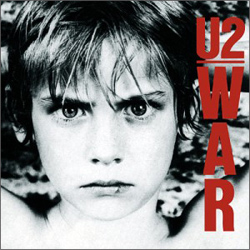 When February blew in this year, there was an immediate rush to celebrate U2’s 30th anniversary release of the War album. I decided to take the high road and sort of waited to celebrate closer to the actual release date of February 28th and then praise the record, which I am surely doing with this short posting.
When February blew in this year, there was an immediate rush to celebrate U2’s 30th anniversary release of the War album. I decided to take the high road and sort of waited to celebrate closer to the actual release date of February 28th and then praise the record, which I am surely doing with this short posting.
What makes the War album special in U2 history is how it launched the band onto the world’s stage. The first two records knocked on the door and third one, War, opened it. It was U2’s first true political record and a turning point in the band’s narrative. They were no longer singing about youth and religion. Instead, they were making music, pinpointing bigger issues outside of the four members. What was great the record was they were blooming and not afraid of taking a stand. They are however Irish and tough blooded men. With Larry’s ferocious drumbeat and Adam holding the low end, the band was now making rhythm an anchor of the narrative. In addition, the musical landscape was changing around them as well. The punk movement had dies and MTV, now a major player in the business, was pushing fluff. Yes, there were videos released from this record in order to build the band’s base, but it was still a grass root effort. Once you heard the record and let it sink in, no matter how you listened to it, one became hooked.
I am surprised that the band has never revisited some of the tunes on recent tours. Yes, I know there is Sunday Bloody Sunday and New Year’s Day, but they have never marched out Two Hearts Beat As One or The Refugee much like they marched out the Electric Co from Boy on recent tours over the past decade. It is my feeling, that the second level tunes on this record, are just as solid as the up-front war-horses, excuse the pun. However, with an impending album release and tour to follow, it would be great for U2 to make a nod to this record and delve deeper into it for the simple reason that this album made them who they are today.
Reflections of Nelson Mandela at 94
 What would this world be like without Nelson Mandela? Cold is the first word that comes to my mind. Empty would be another. I say this because I studied world history in high school back in the 80s where we read numerous articles about Apartheid. I was in no way the aware child back then as I am today as an adult. In fact, South Africa and its issues were so far away from my interest that I slogged through social studies without a care in the world other than wanting to be on my bike, training for another race. It wasn’t until a few years later when U2’s song Silver and Gold brought back my history lesson from high school and threw it in my face. The thing you have to know about me is that I went to a Catholic Preparatory school in Tulsa. Sadly, it wasn’t a melting pot of cultures. We only had one African American kid in our class of thirty-five, which made my well-rounded life a little more insular on the home front. It wasn’t until I got to college, which is where I started to explore issues, thanks to U2 and being surrounded by young, forward thinking students. I don’t regret my parents wanting me to have a great high school education, but it came at a cultural cost.
What would this world be like without Nelson Mandela? Cold is the first word that comes to my mind. Empty would be another. I say this because I studied world history in high school back in the 80s where we read numerous articles about Apartheid. I was in no way the aware child back then as I am today as an adult. In fact, South Africa and its issues were so far away from my interest that I slogged through social studies without a care in the world other than wanting to be on my bike, training for another race. It wasn’t until a few years later when U2’s song Silver and Gold brought back my history lesson from high school and threw it in my face. The thing you have to know about me is that I went to a Catholic Preparatory school in Tulsa. Sadly, it wasn’t a melting pot of cultures. We only had one African American kid in our class of thirty-five, which made my well-rounded life a little more insular on the home front. It wasn’t until I got to college, which is where I started to explore issues, thanks to U2 and being surrounded by young, forward thinking students. I don’t regret my parents wanting me to have a great high school education, but it came at a cultural cost.
As my senior year in college was venturing to it’s spring semester, word was hitting the streets that Mr. Mandela was going to be released from prison. I never thought it would happen. If the word was true, there would be a huge cultural shift in South Africa as the whites had been in powers for years and leading with Apartheid, a system of racial segregation enforced through legislation by the National Party governments, who were the ruling party from 1948 to 1994. That is almost fifty years of rule that had to be overturned. I could not fathom such change in short order. Especially when the United States had its own issues with the racial divide that has gone on for a much longer period of time. What made the events of February 11, 1990, Mandela’s release date, would be one of the biggest cultural shifts of all time.
Now, Apartheid wasn’t abolished on February 12, but South Africans knew that there was a sea change coming. Mr. Mandela began laying the new groundwork for his party, the ANC or African National Congress. He made a statement upon his release to commit to peaceful struggle with the minority white ruling class. In time, he became president and changed the country for the better. The list of his achievements is lengthy, but what he did in four years is a stunning accomplishment. To get 1.5 million children into the education system and provide 3 million with telephone service does not sound like much, but these actions put in place the movement towards a healthier South Africa. Mandela earned accolade upon accolade for moving his country forward. Today, at 94, and long since retired from presidency, South Africans can feel his heartbeat through their country. U2 feels that pulse when they are on tour, playing live in the month of July. They will stop the show and sing Happy Birthday, not to one another, but to Mr. Mandela.
To err, U22, is human, to forgive divine
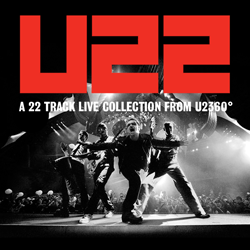 Yesterday, I finally received my U22 booklet and discs. It came to me late because I was moving residences when it was shipped, but I had no fear it would eventually find me. And when it did, I was excited to open it up and start playing the discs.
Yesterday, I finally received my U22 booklet and discs. It came to me late because I was moving residences when it was shipped, but I had no fear it would eventually find me. And when it did, I was excited to open it up and start playing the discs.
As Edge’s wah pedal effect on Even Better Than the Real Thing was wondering out of my speakers, I began to cruise some U2 forums in order to see what others were saying about U22. I, obviously was late to the show, but decided not to do this until I had my prized copy in hand. One such forum had conversations that covered the gamut from what we deserved from the band in our membership to U2.com to songs that were not chosen for the final product. I read deeper as the conversations were becoming more catty than analytical. My saving grace from this school-yard behavior came when I fell into a forum in which someone mentions a printing error he caught in the booklet. My eyes took a double take. I turned around in my chair and retrieved the U22 booklet out from of its protective mailing sleeve and searched for the mistake. As you may not know, I am a graphic designer and searching for printing errors is a hobby. The statement, made in the forum, refers to the printed date next to Even Better Than The Real Thing, which states that it was recorded in Mexico on the 15th of November in 2011. The date doesn’t jive. U2 played Mexico in May of that year and the tour’s completion was in August of 2011. The band was on vacation by November so something was wrong.
I am not here to criticize the proofreader or the designers because these things happen all the time. Trust me, it has happened to me on a few occasions. Luckily, some of my mistakes were caught as we were going to press, but in this case, it wasn’t. So, I ask is this a collectable, such as Billy Ripken’s 1989 baseball card with the expletive written on the bottom of his baseball bat? Probably not, as I do not seeing this piece being reprinted for the masses. Instead, U22 is a collectable for all of us to cherish, regardless of the printing error or not. The booklet, and discs, commemorates one of U2’s finest achievements in touring, next to ZOO TV, which non-U2.com subscribers can admire from afar.
In closing, we live in a fast paced media world in which mistakes like this happen more often than not. Grab any magazine as you are checking out of the grocery store and look at all of the syntax errors in the headlines of advertisers. That alone would drive any English teacher absolutely crazy. In our case, it probably was human error and I forgive the oversight. Instead, the two discs of live tunes included in U22 will forever remind me how I went from the back row on the Joshua Tree tour in Iowa City in 1987 to the pit on the 360 tour. It took me 22 years to get there and that is why I will cherish U22.
The lasting effects of an Irish interview about my book.
 This morning, I received a tweet from a Twitter acquaintance who overheard a conversation on a train in Dublin about my interview with Irish news talk DJ, Tom Dunne, concerning my book about U2. Since the interview was a month ago, I’m amazed that there still is a buzz floating around about the event. To me, Tom’s interview seems like it took place a lifetime ago. Since then, I have packed up my life and moved houses, refinished an antique table, helped my wife choose new lighting for our new space and lastly, getting caught up on life that was left in limbo months ago.
This morning, I received a tweet from a Twitter acquaintance who overheard a conversation on a train in Dublin about my interview with Irish news talk DJ, Tom Dunne, concerning my book about U2. Since the interview was a month ago, I’m amazed that there still is a buzz floating around about the event. To me, Tom’s interview seems like it took place a lifetime ago. Since then, I have packed up my life and moved houses, refinished an antique table, helped my wife choose new lighting for our new space and lastly, getting caught up on life that was left in limbo months ago.
On the morning of my interview with Tom, I had to rise at 4:30 a.m. in order to make the 5:30 a.m. time slot. I was being interviewed over the phone from our house, therefore I could be in my pajamas but I had to be awake. More importantly, I wanted to listen to Tom’s show just to get his vibe, because when it came to my turn to be interviewed, I wanted to tie into the previous conversation. I opened jokingly tying into some Irish boy bands performance in front of some new water feature. I said that Lake Michigan is Chicago’s water feature. It broke the ice for us as we moved into a conversation about how I became a fan of U2. The toughest part of being interviewed live is that you don’t know what questions will be coming at you. I did spend a few days before prepping by reading the book’s press release and then reviewing the highlights, which I knew I had to cover. The most important thing was to be patient and not jump the gun with Tom. Pause and make the interview feel like a natural conversation. This is so not like me, as I can be, not only impatient, but also long-winded. I knew I couldn’t get off track from the questions. I needed to make myself come across, not only coherent, but as a seller of my story.
Tom made me feel comfortable and his professionalism was grand. Everyone I had talked to before the interview told me he was straight up and gracious with his guests. I returned the favor when he asked me about the Paradise Club in Chicago, which doesn’t exist. I didn’t correct him, but marched on with an answer that would satisfy his audience. As I said, I had to think quickly on my feet as it was 5:30 in the morning in Chicago and I was dragging due to packing up our house and readying my wife and I for a life changing moment. And that is where I made my biggest blunder, not selling the book’s web site. You hear it all the time in interviews “Go to my web site where you can get more information at www.blahblahblah.com.” Those conversations bore me because they take fifteen seconds out of the conversation to send me somewhere. More importantly, I would lose focus for the rest of the interview, as I would probably be looking for a pen trying to write down the URL where I could get more information. I didn’t want this to happen to Tom’s listeners. I wanted to make myself believable and inviting.
After listening to the interview, and revisiting the tweet from this morning, I feel as though I did just that, left an indelible mark on someone on a Dublin train in the past few days. Discussing one’s life with a stranger on the radio is tough, but making it inviting is even tougher as you have to peel off your skin and reveal what’s inside. Think of it as an invitation to one’s inner soul. I did just that with humility, but it was a hard road to get to in life. I guess the stars were aligned just so for this to happen. I am sure someone’s looking out for me, wanting me to succeed. Maybe it’s my Mom, who is once again pushing me out to be free as she is about to leave us in the not too distant future. I am not sure, but in any case, none of what has happened with the book has gone to my head, even when a stranger tells you the conversation is about the interview is ongoing.
Click here to take a listen to the interview.
The Joshua Tree turns 25
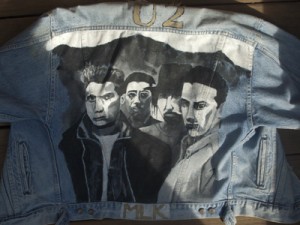 I cannot believe it’s been 25 years since the release of U2’s epic album, The Joshua Tree. First off, the album has stood the test of time. Secondly, I have gotten older. Actually, we, who were in college during that era of the band, have all gotten older but still remember the day the album broke. It’s equivalent would be The Beatles’ Sgt. Peppers or The Rolling Stones’ Exile on Main Street hitting the street. Take your pick of the enormous catalog of great albums released during one’s college years and U2’s sits with the finest. Stealing from The Doors, U2 “broke on through to the other side” with this record. It launched them into the stratosphere.
I cannot believe it’s been 25 years since the release of U2’s epic album, The Joshua Tree. First off, the album has stood the test of time. Secondly, I have gotten older. Actually, we, who were in college during that era of the band, have all gotten older but still remember the day the album broke. It’s equivalent would be The Beatles’ Sgt. Peppers or The Rolling Stones’ Exile on Main Street hitting the street. Take your pick of the enormous catalog of great albums released during one’s college years and U2’s sits with the finest. Stealing from The Doors, U2 “broke on through to the other side” with this record. It launched them into the stratosphere.
In a day in which albums were created almost by an algorithm, or as we called it “by formula” i.e Phil Collins, U2’s album was quite the contrary. U2 created something fresh. There was a story behind each of the 12 songs and the album built a tension, especially if you bought it on a compact disc. (History lesson: it was the first album ever to be released on CD, cassette and vinyl at the same time.) From the opening track of Where The Street Have No Name to Mothers of the Disappeared, The Joshua Tree was a reflection of America with a hint of Irish ambition. Even better, the album’s artwork was a reflection of the starkness of the songs. It was a cut-to-the bone record about America’s interaction with El Salvador in Bullet The Blue Sky as well as visiting U2’s favorite narrative, Christianity. The contrast, or as artists call it chiaroscuro, between religion and politics is not new to the band, but on this record, one wafts from tune to tune not knowing there on this ride. This is what makes this album special.
What would have happened if this album were released as a double LP as it was initially discussed? I feel it wouldn’t have been as great. Don’t get me wrong. Sweetest Thing and Silver and Gold are awesome tracks, but the album would have been too much for us to take on. I don’t think it would have been as tight. It would’ve fallen apart, just like the second side of The Unforgettable Fire does with it’s huge musical landscapes, only be fitting for an album. I like the second side of that album, but to do it again with Race Against Time, a Joshua Tree b-side, wouldn’t have been a smart move. It would have taken away from the tension of the record. Remember, we are in the vinyl era when The Joshua Tree was released and us listeners to the record had to get our butts off the couch to flip the LP. Therefore, I believe the decision to make it one disc and not two was smart.
As for the image for this blog, this is my reaction to The Joshua Tree I painted it in college, shortly after U2 came to Iowa City Iowa in the fall of 1987. For those who have shirts from that leg of the tour, you will notice that Iowa City is not mentioned on them. Cedar Falls is. They did not play on that campus because the band was told to change venues due to their want of putting up their outdoor stage, which would take seven days to put up and tear down. The University of Northern Iowa didn’t want this to happen or so it was the rumor flying around Iowa City at the time. So, they came to my campus. I bought tickets and had the worst seats in the house, but that didn’t matter. It was U2 and I celebrated the night shortly after by painting this jacket in celebration of this event and landmark record.
Mom, I won a Trabbie!!!
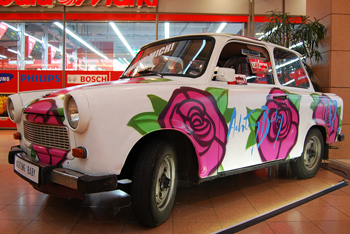 What would your mother say if she heard you say this? Mine would freak. Actually, I would be saying this to my wife. Her response, “where in the hell are we going to put a Trabbie in this 1,600 sq ft condo? I mean seriously! Were you thinking about this when you entered U2.com’s album cover design contest?” I would not hear the end of it. In fact, I am sure the dog and I would be sequestered to the car parked on the street in front of our condo. I would have to beg my wife to let me into our condo, just to use the bathroom.
What would your mother say if she heard you say this? Mine would freak. Actually, I would be saying this to my wife. Her response, “where in the hell are we going to put a Trabbie in this 1,600 sq ft condo? I mean seriously! Were you thinking about this when you entered U2.com’s album cover design contest?” I would not hear the end of it. In fact, I am sure the dog and I would be sequestered to the car parked on the street in front of our condo. I would have to beg my wife to let me into our condo, just to use the bathroom.
With that in mind, I am sure the car that U2 is giving away is not from the ZOO T.V. tour. In fact, I am pretty sure it isn’t. I think the one they are giving away was used for some auto show, pushing the 20th anniversary release of Achtung Baby. The real question is what would I do with a car, painted like Mondrian on acid, which probably barely runs? That is the $65,000 question, which I have no answer for and I am not sure many in this competition do. Add to the fact that we are going to have to pay the expenses of taxes and shipping on this item. Since it’s a car, it will need insurance. I hardly feel anyone has thought among those lines, even me.
But there is something cool about hanging a ZOO T.V. era car from your ceiling, if the ceiling would hold it. You could look underneath it and see its underbelly. With this well made East German before the wall of separation came down poduct, you never know if the transmission might fall out or even worse, spill motor oil on your bearskin rug, which would be a bitch. One idea is turning into a lawn planter. You may have to after three weeks of driving it and paying hundreds in your hard earned currency to get it to your house. It may die somewhere on the side of the road, possibly when you are out running groceries. It will become a lemon (Yes, the pun is intended.) because it is made out of pressed cardboard and been out of production for years. But it’s a Trabbie and you won it with your great graphic design, redesigning an epic U2 album. It can’t die.
Oh, I can see it now. You calling Edge on the phone and asking him to come over and fix it. He’s handy, you think since he has all of those guitar effects that make sweet music. He must know how to fix it. Even better yet, let’s call Willie Williams. He gutted these cars for the Zoo T.V. tour and put lights into them. I am sure he has a set of manuals around somewhere. These thoughts run through your head as you sit in the Trabbie on the side of the road with your cell phone that barely has one bar of reception. People drive by slowly just to look at the brightly painted car with smoke creeping out from under the hood. You think the worst.
So, I ask you, what would you do if you won a U2 Trabbie? Me? If it was one of the classics used on the ZOO T.V. tour? Donate it to a museum and keep the headaches away.
Would you buy an album without U2 on the cover?
It’s a good question and one that should be thought of in the realm of today’s brand and image. Think about it, who cannot go without having their image taken? Not many, except for Christ, maybe. However, if you saw a swoosh, you would identify it with Nike. Therefore, brands don’t need images. However, for brands to sell to people, they need imagery so we can buy in. So, they seek someone out who fits their brand, sports or otherwise, and then get into bed and marry.
Why do I bring this up? Because, if I put a U and 2 together on a page, you got a pretty good picture who this is. You would at least put Bono in your head. Will that number and letter sell an album? Probably not. However, when you are a designer, such as myself, and you take on a project that needs to be pushed, you turn it up a notch. And that is what I did for this U2.com challenge. I took pictures that were the essence of the album and didn’t recreate the albums images in order to mimic what had previously been created. Not that I am knocking those, but this is what happens when you crowdsource.
I know this is a competition, but companies and brands are moving towards crowd sourcing and that is not fair to the creatives, who are thought leaders and branders. I feel U2 isn’t doing this, but they probably want to see who is out there pushing the envelope. I say I did, but I will let you decide.
12
Eric Shivvers 2013 All rights reserved

